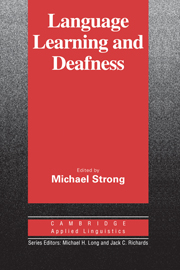Book contents
- Frontmatter
- Contents
- List of contributors
- Series editors' preface
- Preface
- SECTION I THEORETICAL ISSUES
- Chapter 1 Language varieties in the deaf population and their acquisition by children and adults
- Chapter 2 American Sign Language and the human biological capacity for language
- Chapter 3 The history of language use in the education of the Deaf in the United States
- Chapter 4 Sign language instruction and its implications for the Deaf
- Chapter 5 A bilingual approach to the education of young deaf children: ASL and English
- SECTION II RESEARCH REPORTS
- Index
Chapter 1 - Language varieties in the deaf population and their acquisition by children and adults
Published online by Cambridge University Press: 05 October 2012
- Frontmatter
- Contents
- List of contributors
- Series editors' preface
- Preface
- SECTION I THEORETICAL ISSUES
- Chapter 1 Language varieties in the deaf population and their acquisition by children and adults
- Chapter 2 American Sign Language and the human biological capacity for language
- Chapter 3 The history of language use in the education of the Deaf in the United States
- Chapter 4 Sign language instruction and its implications for the Deaf
- Chapter 5 A bilingual approach to the education of young deaf children: ASL and English
- SECTION II RESEARCH REPORTS
- Index
Summary
Editor's introduction
In this chapter, Bochner and Albertini take on the ambitious task of reviewing the central issues in the acquisition of language by deaf individuals in North America. They adopt a self-described “sociolinguistic” perspective by viewing language acquisition by the deaf as occurring under conditions of restricted intake that result in learning patterns resembling those of pidgin and Creole speakers.
In order to explore this analogy in depth, the authors first provide an overview of research on the “products” or linguistic output of deaf learners, including written and spoken English, manual English, Pidgin Sign English (PSE), and American Sign Language (ASL). They then consider various aspects of the acquisition process, particularly those related to the interplay between the organism and the environment, the relationship between communication channel and the mind, and the influence of age on intake.
Apart from the thoroughness with which Bochner and Albertini treat their topic, what makes this chapter an important contribution to applied linguistics is their insights on the relationship between language acquisition among the Deaf and among other speech communities and the implications they draw from the linguistic evidence for the education of deaf children. The importance of primary language acquisition (whether ASL or signed or spoken English) and of the quality of language input/intake for educational advancement is lent an added urgency by the evidence and arguments put forward by these authors.
- Type
- Chapter
- Information
- Language Learning and Deafness , pp. 3 - 48Publisher: Cambridge University PressPrint publication year: 1988
- 11
- Cited by



